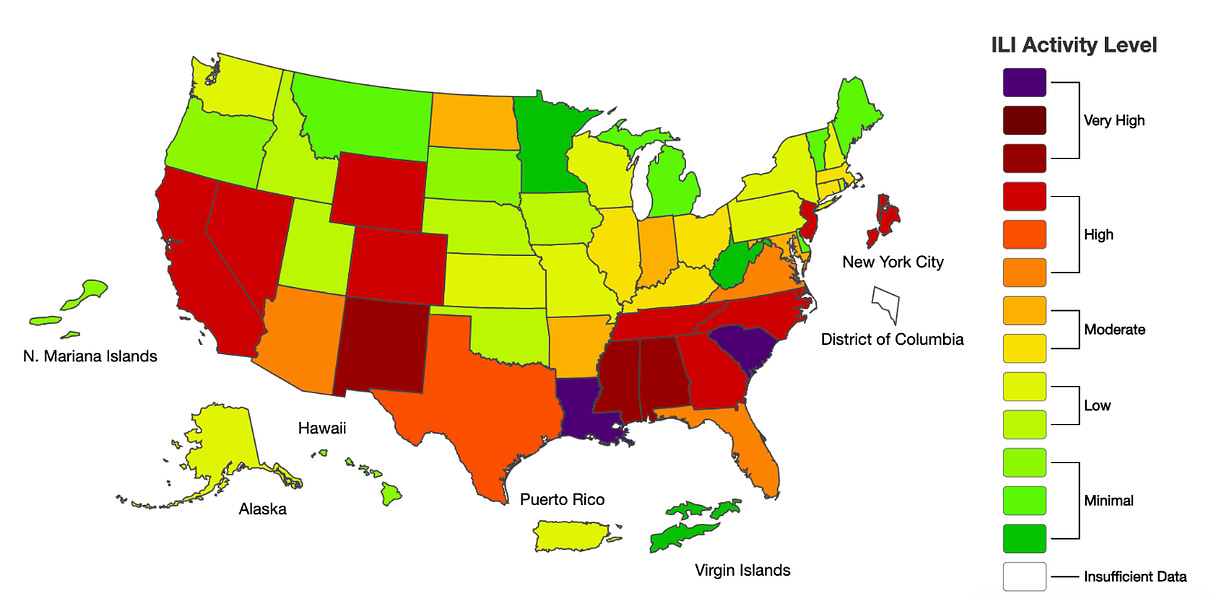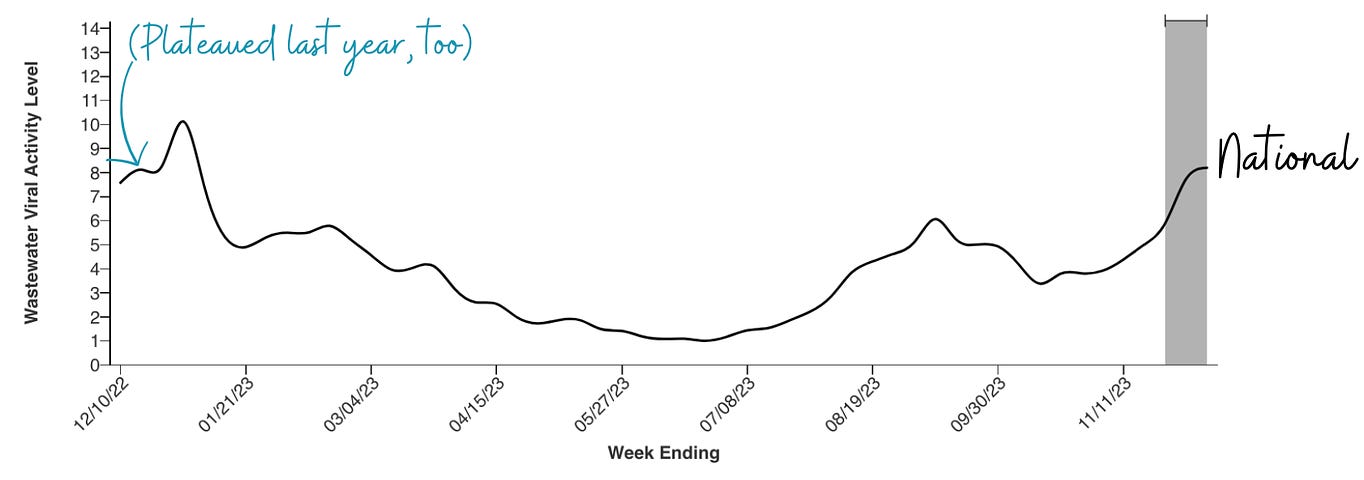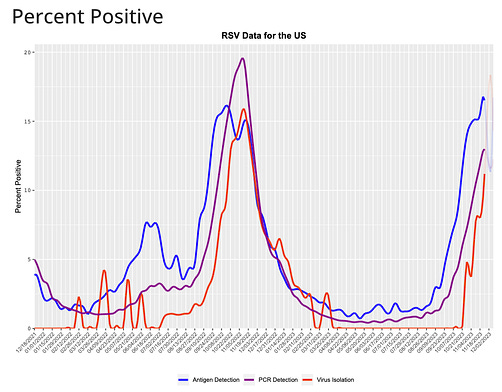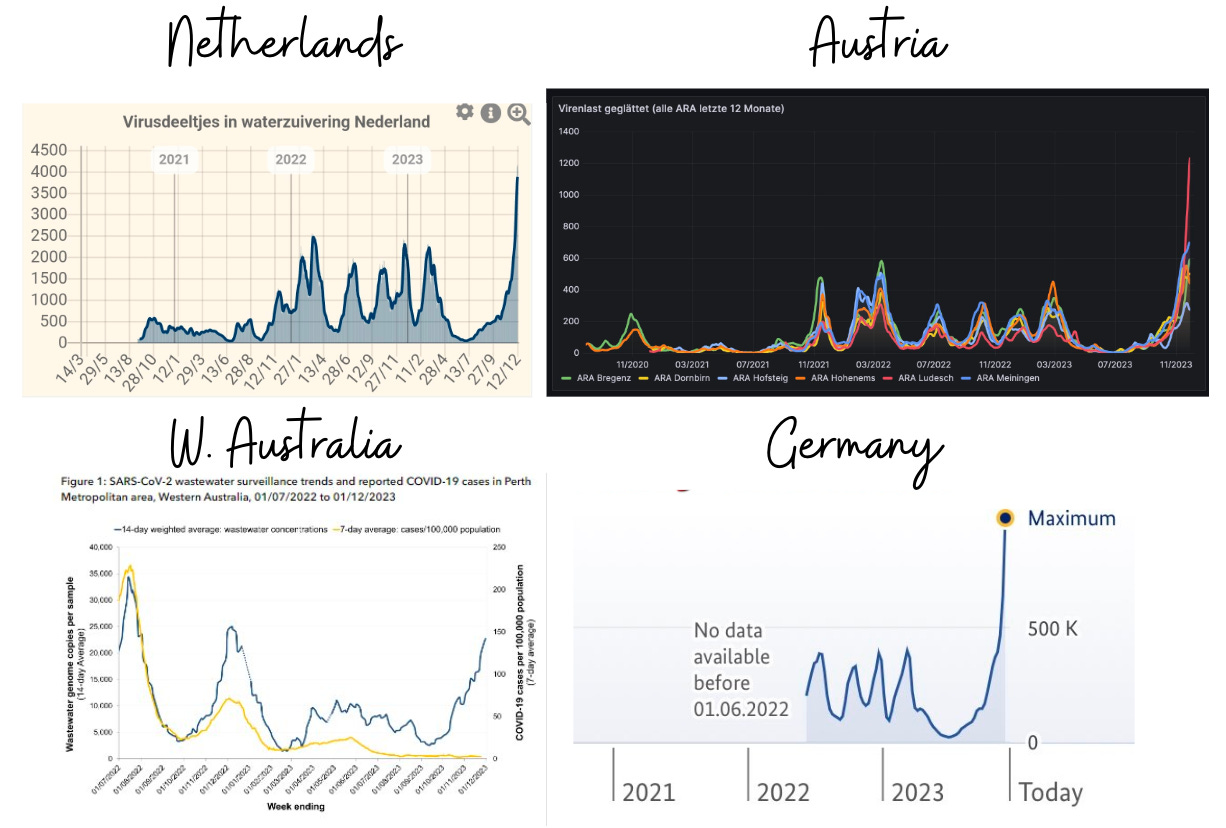Hits: 110
|
 |
Si quiere leer la versión en español, pulse aquí.
In case you missed it, I need your help. Please take a short, 5-minute survey by going HERE. Thanks to all 40,000 (!) of you who have already taken it!
It’s mid-December! Which means shopping, cooking, Santa, school performances, trying to keep sane andddd respiratory illnesses.
Here is your state of affairs.
Influenza-like illnesses: Increasing
The climate of respiratory health in the United States (coined “influenza-like illnesses” by CDC) continues to increase.
This is not surprising, given the holidays and colder weather. What is surprising is that it’s stubbornly creeping up instead of growing exponentially, as it typically does once we pass the epidemic threshold. This should change soon—although I’ve been saying this for weeks.
There are certainly regional differences in respiratory health. Two Southern states have turned “purple,” but many others remain “green” for now. In other words, more people in the South are feeling crappy than in the North.
 |
(Source: CDC)
Our kiddos and older adults are feeling the brunt of severe illnesses.
 |
Hospitalization Rates for Viral Respiratory Illness, by Age (Source: CDC; Annotated by Katelyn Jetelina/YLE)
Here’s a deeper dive into each virus.
Covid-19: High with potential to increase
On a national level, Covid-19 transmission is “very high.” After the post-Thanksgiving springboard upwards, wastewater levels have plateaued. But don’t get too excited. We have consistently seen this pattern in previous years.
 |
National SARS-CoV-2 wastewater levels (Source CDC/ Annotated by Katelyn Jetelina/YLE)
I expect transmission to continue increasing in the weeks to come. Two reasons:
- Holidays. Our social networks expand as we travel and visit with people we don’t normally see. This allows the viruses to find more places to spread.
- Subvariant JN.1 is coming onto the scene. Which one is JN.1 again? It’s the child of BA.2.86, which was discovered in summer. BA.2.86 was concerning because it came out of nowhere with 35 mutations on the spike protein. This is an insane amount of change at once; it’s as big of an evolutionary jump as Wuhan → Omicron. While BA.2.86 was a dud, it quickly mutated to gain one additional spike change (i.e., JN.1). This additional change greatly impacted the viruses’ properties— making it more immune evasive.
JN.1 has become the fastest-growing variant in the past two years. In the U.S., JN.1 is reaching dominance. But, in other countries where JN.1 is already dominant, like Europe, wastewater is uniformly and exponentially increasing, as shown below. This is even the case in Australia even though it is summer there.
The big question is if and how hospitalizations will follow wastewater trends, especially in places like the U.S., where vaccination rates are low. The U.K. and Singapore, which have high vaccination rates, are seeing a steep increase in hospitalizations now that JN.1 has taken over. Last week, CDC warned about the potential impact of low vaccination rates in the U.S.
There is considerable scientific debate about whether JN.1 should be given a new name (next in line would be “Pi”) or if it should still be considered “Omicron.” The Greek naming system was born during the pandemic to help with global scientific communication. However, I’ll be honest: The naming criteria are very unclear. If 35 changes to the spike, lab data showing immune evasion, and associated epidemiological increases don’t qualify for a name change, I’m not sure what will.
RSV: High and… peaking?
RSV decided to surprise many epidemiologists and continue to increase nationally. Hospitalizations have increased 60% over the past four weeks. For our kiddos’ sake, I hope this peaks soon.
 |
RSV test positivity rate United States (Source: CDC)
Flu: Moderate and increasing
Hospitalizations among all age groups increased by 200% for influenza in the past four weeks but remain below Covid-19 and RSV hospitalizations. Flu hospitalizations also remain far below last season’s peak for now.
 |
Hospitalization rate for Covid-19 and Flu, U.S. (Source CDC/ Annotated by KKJ/YLE)
Bottom line
There is a lot of sickness going around, and it will only increase in weeks to come. To improve your odds of staying healthy for the holidays, this is the time to tighten up— wear a mask indoors, get that air moving, and certainly get vaccinated if you haven’t already. And please keep the holiday shopping online if you’re sick.
We can minimize sickness in order to maximize family time coming up.
Love, YLE
In case you missed it:
- It’s the holiday season! Here are simple steps to navigate viruses
- Novavax is here!
- Don’t be surprised if masks come back to hospitals and nursing homes.
“Your Local Epidemiologist (YLE)” is written by Dr. Katelyn Jetelina, MPH PhD—an epidemiologist, data scientist, wife. During the day, she works at a nonpartisan health policy think tank and is a senior scientific consultant to a number of organizations. At night she writes this newsletter. Her main goal is to “translate” the ever-evolving public health science so that people will be well-equipped to make evidence-based decisions. This newsletter is free thanks to the generous support of fellow YLE community members. To support this effort, subscribe below:



